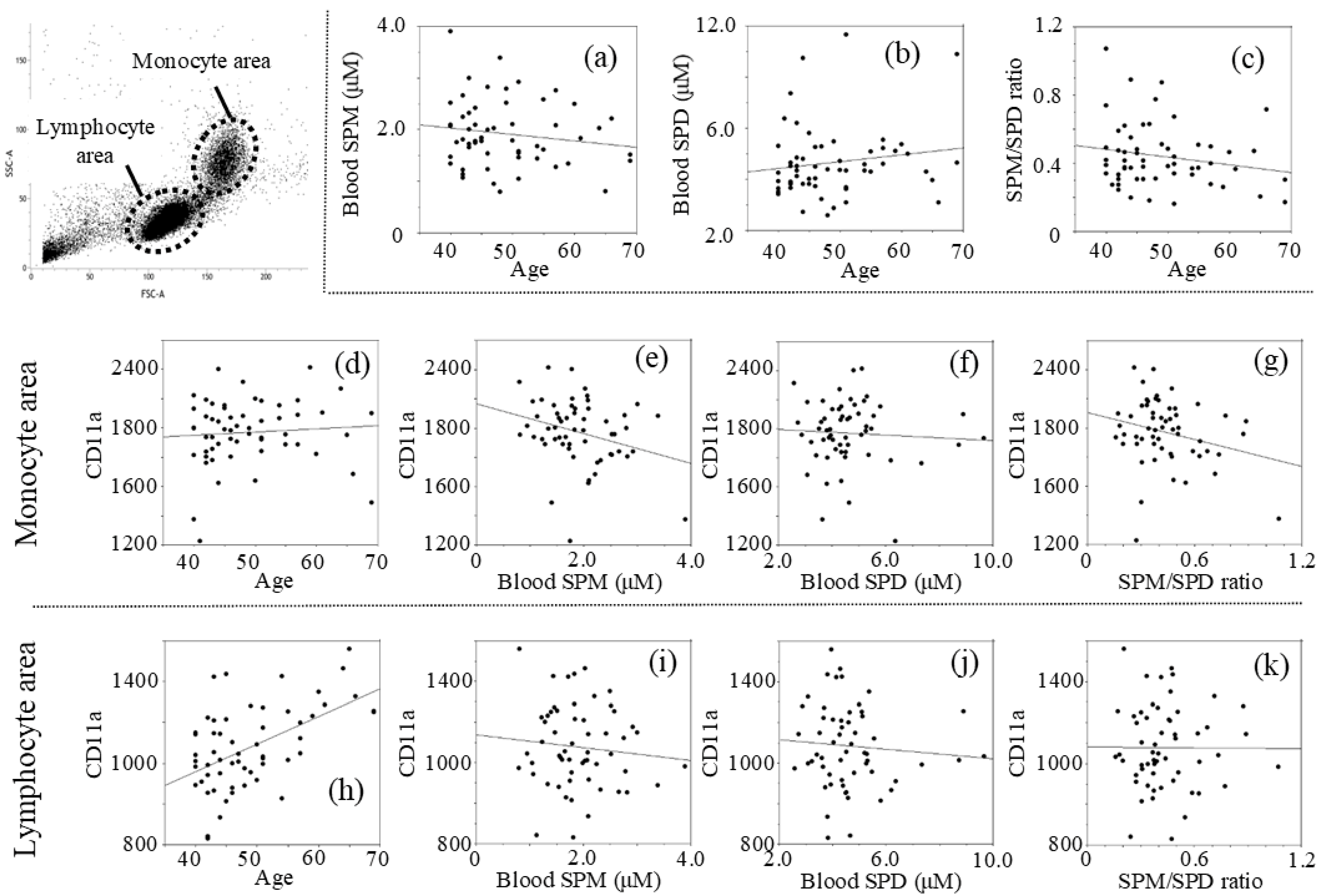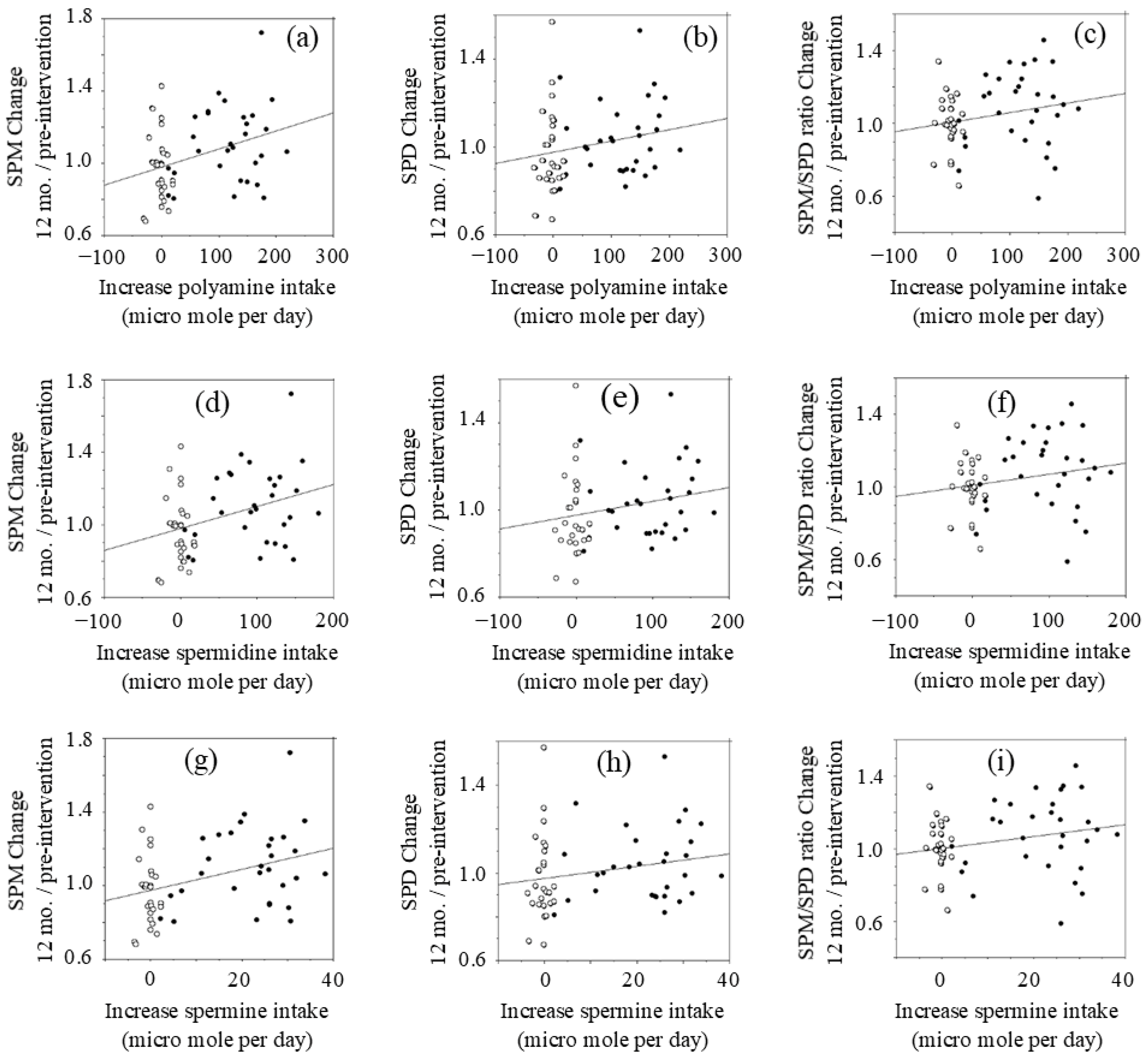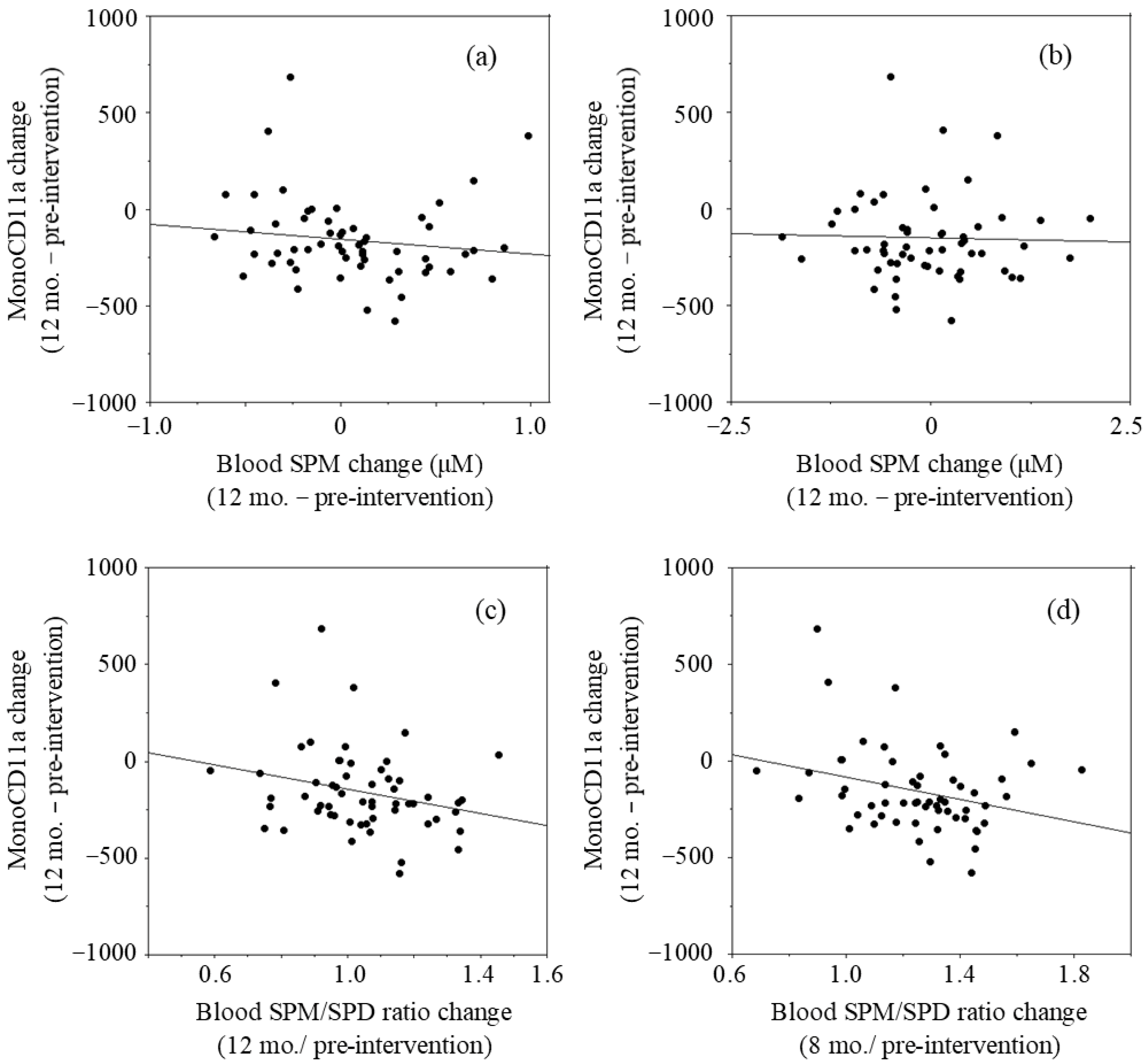Polyamine-Rich Diet Elevates Blood Spermine Levels and Inhibits Pro-Inflammatory Status: An Interventional Study
Abstract
1. Introduction
2. Materials and Methods
2.1. Study Design and Volunteers
2.2. Blood Tests
2.3. Flow Cytometric Analysis
2.4. Determination of Polyamine Concentrations in Whole Blood
2.5. Statistical Analysis
3. Results
3.1. Subjects and Pre-Intervention Parameters
3.2. Blood Tests at Each Time Point
3.3. Changes in Parameters during the Intervention
3.4. Relationship between Increases in Polyamine Intake and Changes in Blood Spermine Levels
3.5. Changes in Parameters of Subjects Without Acute Inflammation and Evaluation of the Effects of SPM on LFA-1 Expression in Monocytes
3.6. Evaluation of the Effects of Changes in Polyamine Concentrations on LFA-1 Expression in the Monocyte Area
4. Discussion
5. Conclusions
Supplementary Materials
Author Contributions
Funding
Institutional Review Board Statement
Informed Consent Statement
Data Availability Statement
Conflicts of Interest
References
- Franceschi, C.; Bonafe, M.; Valensin, S.; Olivieri, F.; De Luca, M.; Ottaviani, E.; De Benedictis, G. Inflamm-aging. An evolutionary perspective on immunosenescence. Ann. N. Y. Acad. Sci. USA 2000, 908, 244–254. [Google Scholar] [CrossRef]
- Collerton, J.; Martin-Ruiz, C.; Davies, K.; Hilkens, C.M.; Isaacs, J.; Kolenda, C.; Parker, C.; Dunn, M.; Catt, M.; Jagger, C.; et al. Frailty and the role of inflammation, immunosenescence and cellular ageing in the very old: Cross-sectional findings from the Newcastle 85+ Study. Mech. Ageing Dev. 2012, 133, 456–466. [Google Scholar] [CrossRef]
- Lopez-Candales, A.; Hernandez Burgos, P.M.; Hernandez-Suarez, D.F.; Harris, D. Linking chronic inflammation with cardiovascular disease: From normal aging to the metabolic syndrome. J. Nat. Sci. 2017, 3, e341. [Google Scholar] [PubMed]
- Fougere, B.; Boulanger, E.; Nourhashemi, F.; Guyonnet, S.; Cesari, M. Chronic inflammation: Accelerator of biological aging. J. Gerontol. 2017, 72, 1218–1225. [Google Scholar] [CrossRef]
- Marioni, R.E.; Shah, S.; McRae, A.F.; Chen, B.H.; Colicino, E.; Harris, S.E.; Gibson, J.; Henders, A.K.; Redmond, P.; Cox, S.R.; et al. DNA methylation age of blood predicts all-cause mortality in later life. Genome Biol. 2015, 16, 25. [Google Scholar] [CrossRef] [PubMed]
- Maeda, M.; Moro, H.; Ushijima, T. Mechanisms for the induction of gastric cancer by Helicobacter pylori infection: Aberrant DNA methylation pathway. Gastric Cancer 2017, 20, 8–15. [Google Scholar] [CrossRef]
- Binh, P.N.T.; Soda, K.; Kawakami, M. Mediterranean diet and polyamine intake: Possible contribution of increased polyamine intake to inhibition of age-associated disease. Nutr. Diet. Suppl. 2011, 3, 1–7. [Google Scholar]
- Bardocz, S.; Brown, D.S.; Grant, G.; Pusztai, A. Luminal and basolateral polyamine uptake by rat small intestine stimulated to grow by Phaseolus vulgaris lectin phytohaemagglutinin in vivo. Biochim. Biophys. Acta 1990, 1034, 46–52. [Google Scholar] [CrossRef]
- Bardocz, S.; Duguid, T.J.; Brown, D.S.; Grant, G.; Pusztai, A.; White, A.; Ralph, A. The importance of dietary polyamines in cell regeneration and growth. Br. J. Nutr. 1995, 73, 819–828. [Google Scholar] [CrossRef] [PubMed]
- Soda, K.; Mogi, S.; Shiina, M.; Nao, K. The Polyamine content in various foods on a calorie basis. J. Food Nutr. 2018, 5, 3106. [Google Scholar]
- Nishibori, N.; Fujihara, S.; Akatuki, T. Amounts of polyamines in foods in Japan and intake by Japanese. Food Chem. 2007, 100, 491–497. [Google Scholar] [CrossRef]
- Soda, K. Polyamine metabolism and gene methylation in conjunction with one-carbon metabolism. Int. J. Mol. Sci. 2018, 19, 3106. [Google Scholar] [CrossRef]
- Soda, K.; Kano, Y.; Nakamura, T.; Kasono, K.; Kawakami, M.; Konishi, F. Spermine, a natural polyamine, suppresses LFA-1 expression on human lymphocyte. J. Immunol. 2005, 175, 237–245. [Google Scholar] [CrossRef]
- Zhang, M.; Caragine, T.; Wang, H.; Cohen, P.S.; Botchkina, G.; Soda, K.; Bianchi, M.; Ulrich, P.; Cerami, A.; Sherry, B.; et al. Spermine inhibits proinflammatory cytokine synthesis in human mononuclear cells: A counterregulatory mechanism that restrains the immune response. J. Exp. Med. 1997, 185, 1759–1768. [Google Scholar] [CrossRef] [PubMed]
- Powers, D.C.; Morley, J.E.; Flood, J.F. Age-related changes in LFA-1 expression, cell adhesion, and PHA-induced proliferation by lymphocytes from senescence-accelerated mouse (SAM)-P/8 and SAM-R/1 substrains. Cell Immunol. 1992, 141, 444–456. [Google Scholar] [CrossRef]
- Chiricolo, M.; Morini, M.C.; Mancini, R.; Beltrandi, E.; Belletti, D.; Conte, R. Cell adhesion molecules CD11a and CD18 in blood monocytes in old age and the consequences for immunological dysfunction. Preliminary results. Gerontology 1995, 41, 227–234. [Google Scholar] [CrossRef]
- Soda, K.; Dobashi, Y.; Kano, Y.; Tsujinaka, S.; Konishi, F. Polyamine-rich food decreases age-associated pathology and mortality in aged mice. Exp. Gerontol. 2009, 44, 727–732. [Google Scholar] [CrossRef]
- Soda, K.; Kano, Y.; Chiba, F.; Koizumi, K.; Miyaki, Y. Increased polyamine intake inhibits age-associated alteration in global DNA methylation and 1,2-dimethylhydrazine-induced tumorigenesis. PLoS ONE 2013, 8, e64357. [Google Scholar] [CrossRef]
- Kano, Y.; Soda, K.; Konishi, F. Suppression of LFA-1 expression by spermine is associated with enhanced methylation of ITGAL, the LFA-1 promoter area. PLoS ONE 2013, 8, e56056. [Google Scholar] [CrossRef]
- Kobayashi, K.; Horii, Y.; Watanabe, S.; Kubo, Y.; Koguchi, K.; Hoshi, Y.; Matsumoto, K.I.; Soda, K. Comparison of soybean cultivars for enhancement of the polyamine contents in the fermented soybean natto using Bacillus subtilis (natto). Biosci. Biotechnol. Biochem. 2017, 81, 587–594. [Google Scholar] [CrossRef]
- Gilad, V.H.; Halperin, R.; Chen-Levy, Z.; Gilad, G.M. Cyclic changes of plasma spermine concentrations in women. Life Sci. 2002, 72, 135–141. [Google Scholar] [CrossRef]
- Nishimura, K.; Shiina, R.; Kashiwagi, K.; Igarashi, K. Decrease in polyamines with aging and their ingestion from food and drink. J. Biochem. 2006, 139, 81–90. [Google Scholar] [CrossRef]
- Elworthy, P.; Hitchcock, E. Polyamine levels in red blood cells from patient groups of different sex and age. Biochim. Biophys. Acta 1989, 993, 212–216. [Google Scholar] [CrossRef]
- van den Berg, G.A.; Muskiet, F.A.; Kingma, A.W.; van der Slik, W.; Halie, M.R. Simultaneous gas-chromatographic determination of free and acetyl-conjugated polyamines in urine. Clin. Chem. 1986, 32, 1930–1937. [Google Scholar] [CrossRef]
- Yodfat, Y.; Weiser, M.; Kreisel, M.; Bachrach, U. Diamine and polyamine levels in the urine of healthy adults. Clin. Chim. Acta 1988, 176, 107–113. [Google Scholar] [CrossRef]
- Soda, K.; Kano, Y.; Sakuragi, M.; Takao, K.; Lefor, A.; Konishi, F. Long-term oral polyamine intake increases blood polyamine concentrations. J. Nutr. Sci. Vitaminol. 2009, 55, 361–366. [Google Scholar] [CrossRef]
- Kibe, R.; Kurihara, S.; Sakai, Y.; Suzuki, H.; Ooga, T.; Sawaki, E.; Muramatsu, K.; Nakamura, A.; Yamashita, A.; Kitada, Y.; et al. Upregulation of colonic luminal polyamines produced by intestinal microbiota delays senescence in mice. Sci. Rep. 2014, 4, 4548. [Google Scholar] [CrossRef]
- Matsumoto, M.; Ohishi, H.; Benno, Y. Impact of LKM512 yogurt on improvement of intestinal environment of the elderly. FEMS Immunol. Med. Microbiol. 2001, 31, 181–186. [Google Scholar] [CrossRef]
- Matsumoto, M.; Kurihara, S.; Kibe, R.; Ashida, H.; Benno, Y. Longevity in mice is promoted by probiotic-induced suppression of colonic senescence dependent on upregulation of gut bacterial polyamine production. PLoS ONE 2011, 6, e23652. [Google Scholar] [CrossRef]
- Hogg, N.; Laschinger, M.; Giles, K.; McDowall, A. T-cell integrins: More than just sticking points. J. Cell Sci. 2003, 116, 4695–4705. [Google Scholar] [CrossRef]
- Vanyushin, B.F.; Tkacheva, S.G.; Belozersky, A.N. Rare bases in animal DNA. Nature 1970, 225, 948–949. [Google Scholar] [CrossRef]
- Wilson, V.L.; Smith, R.A.; Ma, S.; Cutler, R.G. Genomic 5-methyldeoxycytidine decreases with age. J. Biol. Chem. 1987, 262, 9948–9951. [Google Scholar] [CrossRef]
- Hai, Z.; Zuo, W. Aberrant DNA methylation in the pathogenesis of atherosclerosis. Clin. Chim. Acta. 2016, 456, 69–74. [Google Scholar] [CrossRef] [PubMed]
- Ono, T.; Uehara, Y.; Kurishita, A.; Tawa, R.; Sakurai, H. Biological significance of DNA methylation in the ageing process. Age Ageing 1993, 22, S34–S43. [Google Scholar] [CrossRef] [PubMed]
- Chen, B.H.; Marioni, R.E.; Colicino, E.; Peters, M.J.; Ward-Caviness, C.K.; Tsai, P.C.; Roetker, N.S.; Just, A.C.; Demerath, E.W.; Guan, W.; et al. DNA methylation-based measures of biological age: Meta-analysis predicting time to death. Aging 2016, 8, 1844–1865. [Google Scholar] [CrossRef]



| Pre-Intervention | 4 months | 8 months | 12 months | |||||
|---|---|---|---|---|---|---|---|---|
| Group | Intervention | Control | Intervention | Control | Intervention | Control | Intervention | Control |
| n | 30 | 27 | 30 | 26 | 30 | 25 | 30 | 25 |
| SPM | 1.86 ± 0.60 | 1.99 ± 0.68 | 2.09 ± 0.88 | 2.13 ± 0.90 | 2.09 ± 0.72 | 2.04 ± 0.83 | 2.02 ± 0.67 | 1.93 ± 0.86 |
| SPD | 4.71 ± 1.40 | 4.57 ± 1.41 | 4.92 ± 1.65 | 4.50 ± 1.88 | 4.19 ± 1.28 | 3.86 ± 0.99 | 4.81 ± 1.18 | 4.44 ± 1.30 |
| SPM/SPD | 0.42 ± 0.18 | 0.46 ± 0.19 | 0.46 ± 0.23 | 0.50 ± 0.21 | 0.53 ± 0.23 | 0.55 ± 0.25 | 0.45 ± 0.20 | 0.46 ± 0.21 |
| hs-CRP | 1207.07 ± 4064.23 | 1316.26 ± 1494.05 | 1849.63 ± 3705.88 | 1561.89 ± 3924.60 | 742.63 ± 1369.05 | 818.76 ± 1098.17 | 3490.67 ± 10250.95 | 895.48 ± 1045.75 |
| Lymph-CD11a MFI | 1082.87 ± 230.87 | 1074.85 ± 168.84 | 1102.90 ± 200.65 | 1090.04 ± 173.25 | 1051.80 ± 201.22 | 1015.92 ± 170.99 | 994.17 ± 176.34 | 999.36 ± 143.28 |
| Mono-CD11a MFI | 2040.20 ± 185.55 *1 | 1891.59 ± 241.72 | 1851.90 ± 174.40 *2 | 1716.58 ± 242.24 | 1882.83 ± 200.45 | 1852.64 ± 171.63 | 1808.47 ± 176.95 | 1805.40 ± 192.56 |
| SI | 232.65 ± 104.66 | 213.94 ± 92.85 | 234.86 ± 64.44 | 208.65 ± 67.57 | 146.74 ± 49.78 | 159.05 ± 55.41 | 206.29 ± 84.99 | 193.29 ± 85.22 |
| HDL | 62.53 ± 15.15 | 65.26 ± 20.97 | 61.33 ± 16.16 | 58.35 ± 16.53 | 60.87 ± 17.60 | 58.48 ± 17.36 | 65.13 ± 20.93 | 63.16 ± 16.48 |
| LDL | 128.47 ± 39.81 | 121.37 ± 35.03 | 123.97 ± 31.79 | 122.62 ± 33.04 | 117.43 ± 27.99 | 118.88 ± 28.50 | 133.10 ± 37.10 | 130.6 ± 36.68 |
| T-Cho | 212.07 ± 43.17 | 207.89 ± 41.26 | 205.47 ± 33.50 | 200.96 ± 34.56 | 203.37 ± 34.49 | 195.80 ± 31.47 | 219.77 ± 38.69 | 216.52 ± 40.15 |
| Pre−Intervention | 4 months | 8 months | 12 months | |||||
|---|---|---|---|---|---|---|---|---|
| Group | Intervention | Control | Intervention | Control | Intervention | Control | Intervention | Control |
| n | 30 | 27 | 30 | 26 | 30 | 25 | 30 | 25 |
| Age | 50.20 ± 7.85 | 47.48 ± 7.84 | 50.20 ± 7.85 | 47.35 ± 7.96 | 50.20 ± 7.85 | 47.64 ± 7.98 | 50.20 ± 7.85 | 47.64 ± 7.98 |
| SPM change rate | 1 | 1 | 1.13 ± 0.32 | 1.07 ± 0.36 | 1.16 ± 0.32 | 1.04 ± 0.22 | 1.12 ± 0.29 *1 | 0.97 ± 0.19 |
| SPD change rate | 1 | 1 | 1.04 ± 0.24 | 0.98 ± 0.28 | 0.90 ± 0.18 | 0.85 ± 0.13 | 1.04 ± 0.17 | 0.97 ± 0.20 |
| SPM/SPD change rate | 1 | 1 | 1.09 ± 0.25 | 1.09 ± 0.23 | 1.31 ± 0.26 | 1.23 ± 0.21 | 1.09 ± 0.24 | 1.01 ± 0.13 |
| hs-CRP | 0 | 0 | 642.57 ± 5570.59 | 203.23 ± 4405.73 | −464.43 ± 4318.86 | −587.16 ± 1946.86 | 2733.60 ± 11253.34 *2 | −510.44 ± 1589.16 |
| Lymph- CD11aMFI | 0 | 0 | 20.03 ± 101.61 | 13.23 ± 105.50 | −31.07 ± 137.57 | −62.36 ± 140.72 | −88.7 ± 121.66 | −78.92 ± 100.38 |
| Mono- CD11aMFI | 0 | 0 | −188.30 ± 201.57 | −169.12 ± 221.79 | −157.37 ± 186.48 | −35.84 ± 213.36 | −231.73 ± 166.33 | −83.08 ± 249.52 |
| SI | 0 | 0 | 2.20 ± 92.58 | 3.17 ± 89.32 | −85.91 ± 115.63 | −47.31 ± 71.28 | −24.110 ± 134.46 | −13.08 ± 78.66 |
| HDL | 0 | 0 | −1.20 ± 7.02 | −4.77 ± 6.37 | −1.67 ± 7.81 | −4.56 ± 8.10 | 2.60 ± 11.51 | 0.12 ± 7.89 |
| LDL | 0 | 0 | −4.50 ± 26.89 | −0.81 ± 18.97 | −11.03 ± 26.45 | −5.36 ± 17.12 | 4.63 ± 29.21 | 6.36 ± 20.55 |
| T-Cho | 0 | 0 | −6.60 ± 28.08 | −7.04 ± 27.79 | −8.70 ± 30.30 | −12.88 ± 24.34 | 7.70 ± 34.17 | 7.84 ± 26.62 |
| Pre−Intervention | 4 months | 8 months | 12 months | |||||
|---|---|---|---|---|---|---|---|---|
| Group | Intervention | Control | Intervention | Control | Intervention | Control | Intervention | Control |
| n | 30 | 27 | 24 | 22 | 27 | 20 | 23 | 23 |
| age | 50.20 ± 7.85 | 47.48 ± 7.84 | 49.75 ± 7.79 | 46.82 ± 7.15 | 50.19 ± 8.09 | 48.85 ± 8.48 | 49.65 ± 7.67 | 47.96 ± 8.25 |
| SPM change rate | 1 | 1 | 1.10 ± 0.33 | 1.04 ± 0.33 | 1.19 ± 0.33 | 1.07 ± 0.22 | 1.08 ± 0.18 *1 | 0.98 ± 0.20 |
| SPD change rate | 1 | 1 | 1.05 ± 0.25 | 0.95 ± 0.22 | 0.90 ± 0.18 | 0.85 ± 0.13 | 1.04 ± 0.17 | 0.96 ± 0.20 |
| SPM/SPD change rate | 1 | 1 | 1.05 ± 0.21 | 1.08 ± 0.16 | 1.33 ± 0.26 | 1.28 ± 0.20 | 1.05 ± 0.19 | 1.02 ± 0.13 |
| hs-CRP | 0 | 0 | −500 ± 624.63 | −109.68 ± 885.95 | −46.70 ± 588.73 | −160.85 ± 556.02 | −32.87 ± 482.02 | −139.35 ± 879.41 |
| Lymph- CD11aMFI | 0 | 0 | 7.46 ± 104.56 | 17.46 ± 103.27 | −38.52 ± 141.15 | −65.90 ± 133.64 | −99.00 ± 129.77 | −70.83 ± 96.42 |
| Mono- CD11aMFI | 0 | 0 | −209.08 ± 214.63 | −177.41 ± 222.79 | −156.63 ± 196.33 | −47.10 ± 226.90 | −247.83 ± 148.76 *2 | −85.04 ± 257.39 |
| 4 months—Pre-Intervention | 8 months—Pre-Intervention | 12 months—Pre-Intervention | ||||
|---|---|---|---|---|---|---|
| Group | Intervention | Control | Intervention | Control | Intervention | Control |
| SPM (MIM approach) | 0.120 ± 0.257 | 0.0005 ± 0.220 (−0.006 ± 0.258) | 0.228 ± 0.428 | 0.055 ± 0.381 (0.057 ± 0.403) | 0.161 ± 0.373 *1 | −0.049 ± 0.381 (−0.052 ± 0.403) |
| SPD (MIM approach) | −0.182 ± 0.583 | −0.268 ± 0.510 (−0.200 ± 0.602) | −0.520 ± 0.904 | −0.734 ± 0.792 (−0.697 ± 0.839) | −0.093 ± 0.756 | 0.195 ± 0.795 (−0.116 ± 0.869) |
| SPM/SPD ratio (MIM approach) | 1.133 ± 0.164 | 1.074 ± 0.137 (1.060 ± 0.164) | 1.290 ± 0.225 | 1.214 ± 0.209 (1.210 ± 0.224) | 1.078 ± 0.207 | 1.005 ± 0.129 (0.990 ± 0.153) |
| Mono−CD11aMFI (MIM approach) | −188.30 ± 201.57 | −152.17 ± 220.65 (−162.70 ± 218.61) | −157.37 ± 205.24 *1 | −33.02 ± 205.24 (−37.73 ± 207.55) | −231.73 ± 166.33 *2 | −76.59 ± 240.87 (−86.07 ± 240.06) |
Publisher’s Note: MDPI stays neutral with regard to jurisdictional claims in published maps and institutional affiliations. |
© 2021 by the authors. Licensee MDPI, Basel, Switzerland. This article is an open access article distributed under the terms and conditions of the Creative Commons Attribution (CC BY) license (http://creativecommons.org/licenses/by/4.0/).
Share and Cite
Soda, K.; Uemura, T.; Sanayama, H.; Igarashi, K.; Fukui, T. Polyamine-Rich Diet Elevates Blood Spermine Levels and Inhibits Pro-Inflammatory Status: An Interventional Study. Med. Sci. 2021, 9, 22. https://doi.org/10.3390/medsci9020022
Soda K, Uemura T, Sanayama H, Igarashi K, Fukui T. Polyamine-Rich Diet Elevates Blood Spermine Levels and Inhibits Pro-Inflammatory Status: An Interventional Study. Medical Sciences. 2021; 9(2):22. https://doi.org/10.3390/medsci9020022
Chicago/Turabian StyleSoda, Kuniyasu, Takeshi Uemura, Hidenori Sanayama, Kazuei Igarashi, and Taro Fukui. 2021. "Polyamine-Rich Diet Elevates Blood Spermine Levels and Inhibits Pro-Inflammatory Status: An Interventional Study" Medical Sciences 9, no. 2: 22. https://doi.org/10.3390/medsci9020022
APA StyleSoda, K., Uemura, T., Sanayama, H., Igarashi, K., & Fukui, T. (2021). Polyamine-Rich Diet Elevates Blood Spermine Levels and Inhibits Pro-Inflammatory Status: An Interventional Study. Medical Sciences, 9(2), 22. https://doi.org/10.3390/medsci9020022






